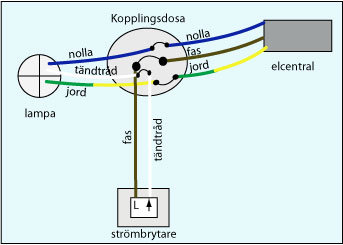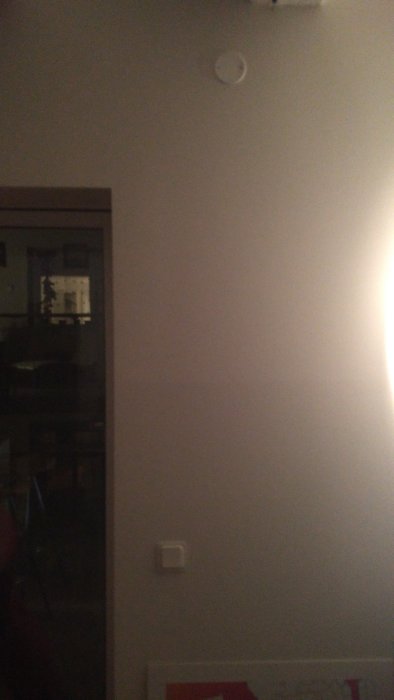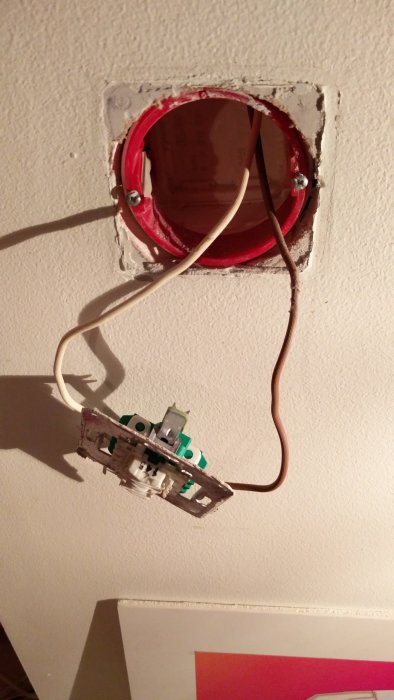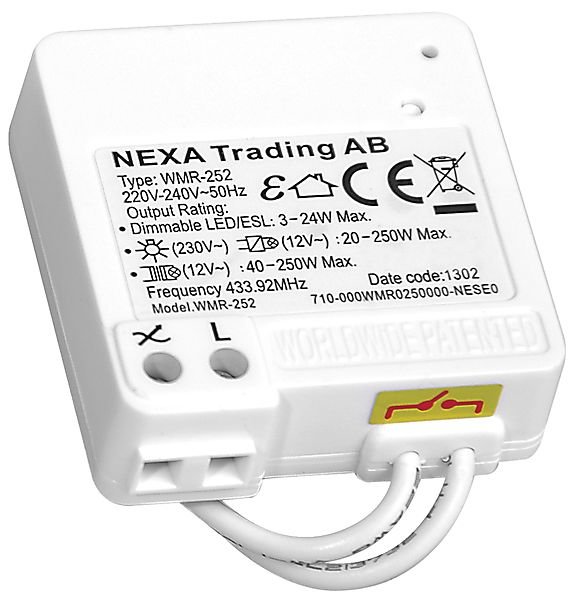Hello,
I'm American and don't quite understand how things connect in Sweden. I feel kind of stupid, but I have changed regular switches to dimmers before in the US and installation was easy. Here's my problem and if anyone can help, I'd appreciate it:
I believe my lights are connected as such:

Switch and junction box:

Wires at switch:

I checked both the switch and the plug and those are exactly the colors I found.
Nexa WMR-252

According to these instructions, I've tried connecting the brown wire to L and the white to the other. The LED is supposed to turn on, but it did not. I tried it the other way around, but it didn't work that way either. What am I doing wrong?
I'm willing to try any other Nexa dimmer (I bought this one so that I wouldn't have to buy a remote switch) if that makes installation easier. I'm even willing to go with a simple on/off one, but that has 4 connections which I don't quite understand where to place it.
Any how, any information would help. A sketch would be awesome.
Thanks,
Tien
I'm American and don't quite understand how things connect in Sweden. I feel kind of stupid, but I have changed regular switches to dimmers before in the US and installation was easy. Here's my problem and if anyone can help, I'd appreciate it:
I believe my lights are connected as such:

Inloggade ser högupplösta bilder
Logga in
Skapa konto
Gratis och tar endast 30 sekunder
Switch and junction box:

Inloggade ser högupplösta bilder
Logga in
Skapa konto
Gratis och tar endast 30 sekunder
Wires at switch:

Inloggade ser högupplösta bilder
Logga in
Skapa konto
Gratis och tar endast 30 sekunder
I checked both the switch and the plug and those are exactly the colors I found.
Nexa WMR-252

Inloggade ser högupplösta bilder
Logga in
Skapa konto
Gratis och tar endast 30 sekunder
According to these instructions, I've tried connecting the brown wire to L and the white to the other. The LED is supposed to turn on, but it did not. I tried it the other way around, but it didn't work that way either. What am I doing wrong?
I'm willing to try any other Nexa dimmer (I bought this one so that I wouldn't have to buy a remote switch) if that makes installation easier. I'm even willing to go with a simple on/off one, but that has 4 connections which I don't quite understand where to place it.
Any how, any information would help. A sketch would be awesome.
Thanks,
Tien
Hi and welcome 
You should connect the brown wire to L and the white to the other.
But u also need to connect the white wires from the dimmer to your switch.
Connect them at the same places as the brown and white were connected.
If you dont want to use a remote you could use a more traditional dimmer like this one:
http://elbutik.se/product.html/jussi-vriddimmer-for-glodljus-och-elektronisk-trafo?category_id=277
You should connect the brown wire to L and the white to the other.
But u also need to connect the white wires from the dimmer to your switch.
Connect them at the same places as the brown and white were connected.
If you dont want to use a remote you could use a more traditional dimmer like this one:
http://elbutik.se/product.html/jussi-vriddimmer-for-glodljus-och-elektronisk-trafo?category_id=277
No, that is not the problem. The problem is that you have a LED lamp and your Nexa switch does not have its own neutral conductor. A normal incandescent light lets a small amount of current through so the switch can "steal" neutral through the connected load. A LED with electronic driver does not. The solution is to use a switch which has its own neutral lead, such as http://www.nexa.se/vara-produkter/system-nexa/mottagare-dimmers/cmr-101. This gives another problem, you have no neutral lead in the wall box. This needs to be inserted from the junction box that feeds your wall box, probably the one just above. You also can't use the wall switch anymore since the CMR-101 does not have provision for attaching one.
All of this is illegal to do in Sweden if you are not a certified electrician or working under supervision. It would be very advisable for you to call a local electrician to help you.
Also, never trust colors, you need to be sure of which lead does what, preferably by following it all the way.
All of this is illegal to do in Sweden if you are not a certified electrician or working under supervision. It would be very advisable for you to call a local electrician to help you.
Also, never trust colors, you need to be sure of which lead does what, preferably by following it all the way.
Redigerat:
Har han inte kopplat in strömställaren så kan inte dimmern fungera.
Dimmern är avsedd för LED enligt Nexa och nolla ska inte behövas.
I'm lazy and using Google Translate:
Has he did not connect the switch can not dimmer function.
The dimmer is designed for LED according Nexa and neutral should not be necessary.
Dimmern är avsedd för LED enligt Nexa och nolla ska inte behövas.
I'm lazy and using Google Translate:
Has he did not connect the switch can not dimmer function.
The dimmer is designed for LED according Nexa and neutral should not be necessary.
This is the manual for Nexa WMR-252: http://www.nexa.se/wp-content/uploads/2015/06/WMR-252-bruksanvisning.pdf
Please see second page. The wires to the switch are not required and should be separately insulated if not used.
I see now that TS wanted to use the switch functionality to avoid buying a separate remote. Obviously, the white wires should then be connected to the switch. The order does not matter. However, In this case I really don't see the point in buying this particular product. The product recommended by maah is perfect.
Regarding the neutral: As I said, all electronic devices require live and neutral (at the very least). In this case the neutral is provided through the load (the light). With LED, this can be a dicey proposition and does not always work. The best way is to use a dimmer with separate neutral. The second best is to install a bypass, or "Bottenlast", parallell with the light. This is somewhat more tricky.
Please see second page. The wires to the switch are not required and should be separately insulated if not used.
I see now that TS wanted to use the switch functionality to avoid buying a separate remote. Obviously, the white wires should then be connected to the switch. The order does not matter. However, In this case I really don't see the point in buying this particular product. The product recommended by maah is perfect.
Regarding the neutral: As I said, all electronic devices require live and neutral (at the very least). In this case the neutral is provided through the load (the light). With LED, this can be a dicey proposition and does not always work. The best way is to use a dimmer with separate neutral. The second best is to install a bypass, or "Bottenlast", parallell with the light. This is somewhat more tricky.
Hello,
Thanks for the advice. Questions:
1) How can you tell that the lighting was made for LED?
2) How much would it typically cost for the electrician? I just need 3 remote controlled lights installed. 2 on/off and 1 dimmer. Some have light switches in the most unusual place and it's annoying to have search for them every time. Plus I have a Tellstick for home automation that I'd like to put to use.
3) Why is it illegal to change a "simple" lightswitch? I'm just curious. They expect you to splice your own light fixtures and other things. What other things are illegal? Is there a typical rule of thumb? Not being sarcastic - I honestly don't know.
Thanks,
Tien
Thanks for the advice. Questions:
1) How can you tell that the lighting was made for LED?
2) How much would it typically cost for the electrician? I just need 3 remote controlled lights installed. 2 on/off and 1 dimmer. Some have light switches in the most unusual place and it's annoying to have search for them every time. Plus I have a Tellstick for home automation that I'd like to put to use.
3) Why is it illegal to change a "simple" lightswitch? I'm just curious. They expect you to splice your own light fixtures and other things. What other things are illegal? Is there a typical rule of thumb? Not being sarcastic - I honestly don't know.
Thanks,
Tien
Cant really answer 1 & 2.
3, You are allowed to replace a switch with another switch if you have the knowledge but for some reason you are not allowed to replace a switch with a dimmer.
You are allowed to splice the light fixture because it is connected with a plug to an outlet. You are not allowed to do (almost) anything regarding the fixed installation i.e anything behind the outlet. The exception is that you can replace existing switches and sockets.
3, You are allowed to replace a switch with another switch if you have the knowledge but for some reason you are not allowed to replace a switch with a dimmer.
You are allowed to splice the light fixture because it is connected with a plug to an outlet. You are not allowed to do (almost) anything regarding the fixed installation i.e anything behind the outlet. The exception is that you can replace existing switches and sockets.
1. You wrote that the LED should turn on. I realise now that you possibly ment the LED on the switch, not the actual light. If so you still might have the problem I described. It can also occur with low energy lights. Traditional incandescents should work, try one of those in the light socket just to see if it works.
2. Impossible to say. They usually charge 500-600 SEK/h + fee for car (don't get me started). This particular switch should not take more than 15 minutes to fix. The others are impossible to say.
3. You are allowed to do the following things:
Change light switches to new of the same type
Change outlets to new of the same type, ie no installing earthed sockets if the original is unearthed
Change a permanently mounted light fixture in a dry room
Change bulbs
Change fuses (not change circuit breakers, that is completely different)
The rule of thumb is very simple, you can't do anything (except for the things mentioned above).
With stuff attached with a plug to an outlet, you can do (almost) whatever you want, but you can't sell the result.
Why this is so is discussed a lot in other threads in this forum (in swedish), many of us think the law is silly but it is the law.
I'm curious though. You mention in your first post that you bought that particular switch to avoid buying a remote. In your second post you mention remote control and tellstick.
2. Impossible to say. They usually charge 500-600 SEK/h + fee for car (don't get me started). This particular switch should not take more than 15 minutes to fix. The others are impossible to say.
3. You are allowed to do the following things:
Change light switches to new of the same type
Change outlets to new of the same type, ie no installing earthed sockets if the original is unearthed
Change a permanently mounted light fixture in a dry room
Change bulbs
Change fuses (not change circuit breakers, that is completely different)
The rule of thumb is very simple, you can't do anything (except for the things mentioned above).
With stuff attached with a plug to an outlet, you can do (almost) whatever you want, but you can't sell the result.
Why this is so is discussed a lot in other threads in this forum (in swedish), many of us think the law is silly but it is the law.
I'm curious though. You mention in your first post that you bought that particular switch to avoid buying a remote. In your second post you mention remote control and tellstick.
Tommib,
Okay. I get why that confused you about the LED. Yes, I meant on the unit itself. Unfortunately, brown to L and white to the other does not work with a halogen bulb, which I am guessing means it won't work with any other one. I guess I should try it with several bulb types to see. Unfortunately, incandescent bulbs are hard to find (non-halogen, "regular" bulbs). If none of them work, I guess I'll just buy a 4 lead one and have it installed near the light plug outlet instead.
As for why I wanted to use this particular Nexa product, I didn't want to lose functionality of my existing switch. Supposedly, placed behind the switch, it keeps the function of the switch, but also adds remote control. (I guess that it no longer has an "up is on, down is off", but rather acts as a on/off toggle.)
The other Nexa products that don't have these leads for the switch means that the switch itself must be replaced a remote one - one ilke this from Nexa. The only advantage to that is you can locate it anywhere you want. The disadvantage is that you have to buy an extra product.
While I like using remote control, a wall switch will not fall behind the couch. I'll still be able to turn on the lights without having to search around for the remote (or open the app in my phone). That's why I want that functionality.
Thanks,
Tien
Okay. I get why that confused you about the LED. Yes, I meant on the unit itself. Unfortunately, brown to L and white to the other does not work with a halogen bulb, which I am guessing means it won't work with any other one. I guess I should try it with several bulb types to see. Unfortunately, incandescent bulbs are hard to find (non-halogen, "regular" bulbs). If none of them work, I guess I'll just buy a 4 lead one and have it installed near the light plug outlet instead.
As for why I wanted to use this particular Nexa product, I didn't want to lose functionality of my existing switch. Supposedly, placed behind the switch, it keeps the function of the switch, but also adds remote control. (I guess that it no longer has an "up is on, down is off", but rather acts as a on/off toggle.)
The other Nexa products that don't have these leads for the switch means that the switch itself must be replaced a remote one - one ilke this from Nexa. The only advantage to that is you can locate it anywhere you want. The disadvantage is that you have to buy an extra product.
While I like using remote control, a wall switch will not fall behind the couch. I'll still be able to turn on the lights without having to search around for the remote (or open the app in my phone). That's why I want that functionality.
Thanks,
Tien
Ok. You are correct in assuming that the switch won't work as usual. You need to add a small spring to it to make it an impulse switch. This is secondary however. Halogen bulbs are the same as incandescents in this regard, it should work. As Peter2400 asked, does the light work if you put white and brown together? If so, your reciever is broken or badly configured. Did you try it out by putting the two white leads together quickly?

